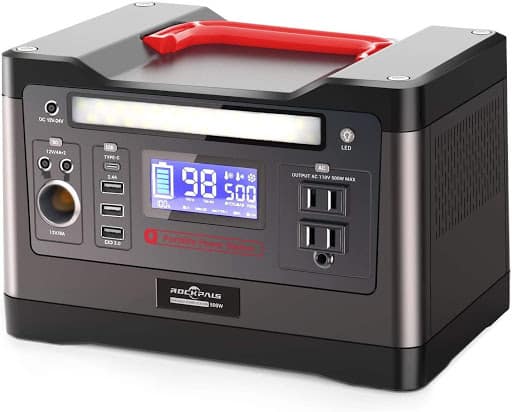In this article, we will compare 10 different power stations and their characteristics.
Since these work best for different situations, there is no way to declare a winner, but relevant information will be provided so that the user knows which option is best to meet their needs.
I’ll be starting with the largest power stations and then work down to the lightweight models.
Keep in mind that the larger solar generators are very heavy (2,000Wh+) and the ones listed at about 1,000Wh and lower are significantly lighter in most cases.
If you’re looking for a portable power station that can be carried easily, these can be found beginning at about halfway down the article, starting with the Rockpals 500 model.
If you’re looking specifically for large solar generators, the first three models in this post have much larger batteries than the rest (the Inergy Flex starts small, but can expand its battery capacity).
If you’d like to see more large power stations, I have a post comparing four different models that you can read here: 3 Best Solar Generators for Off-Grid Living + Scoring Breakdown.
| Brand | Point Zero Energy | Inergy | Goal Zero | Maxoak | EcoFlow | Jackery | Rockpals | Goal Zero | Jackery | Aeiusny |
|---|---|---|---|---|---|---|---|---|---|---|
| Model | Titan | Flex 1500 | YETI 3000 Lithium | Bluetti EB150 | Delta 1300 | Explorer 1000 | 500W/540Wh | YETI 500X | Explorer 500 | 400W |
| Image | 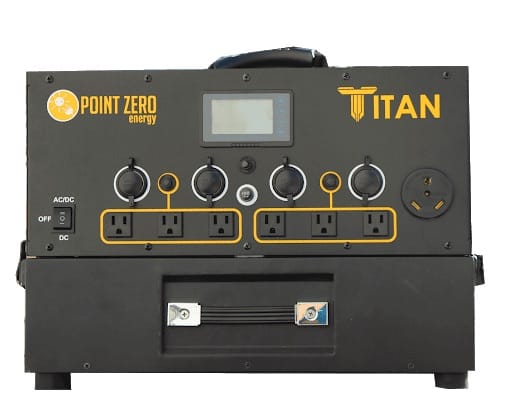 | 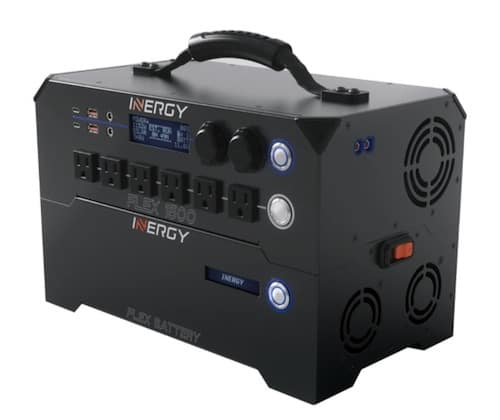 | 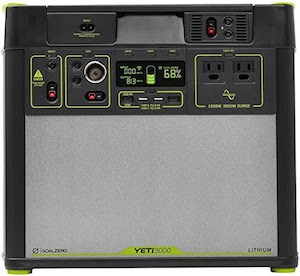 | 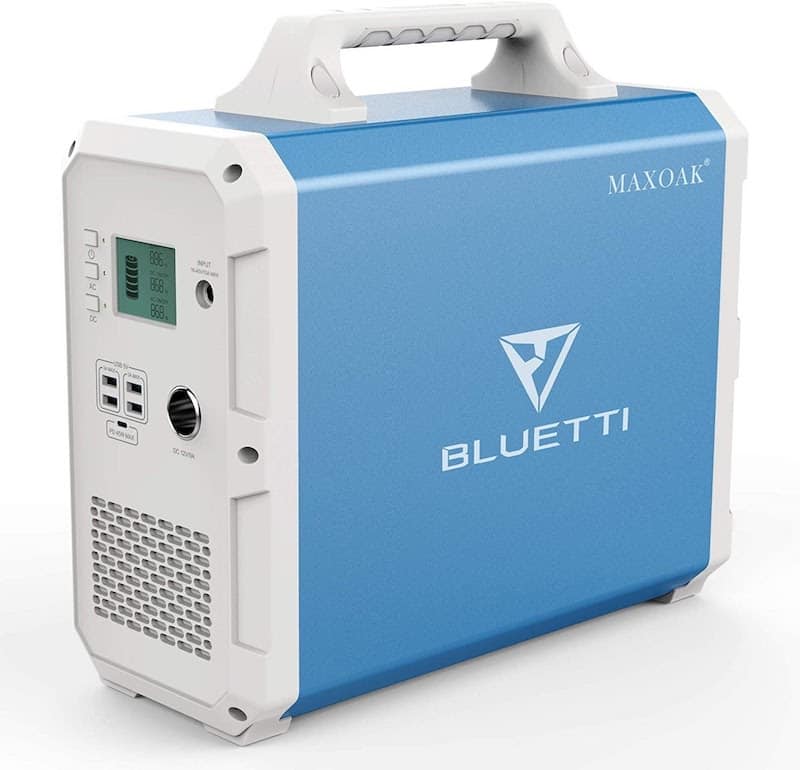 |  | 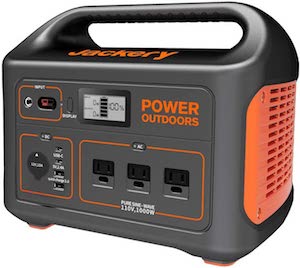 | 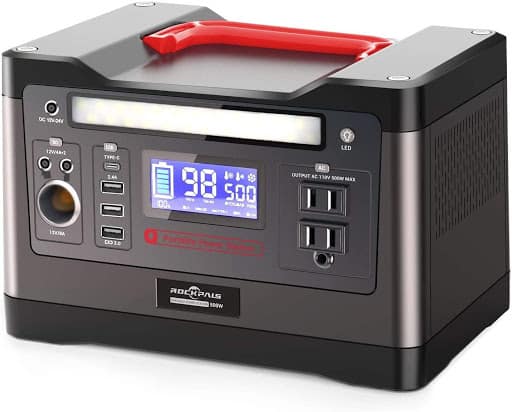 |  | 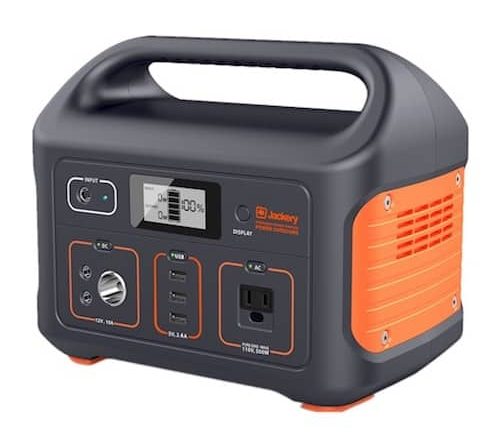 | 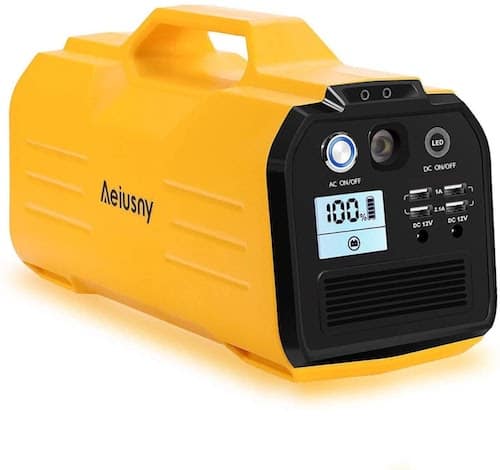 |
| Capacity | 2,000Wh+ | 1,500Wh+ | 3,075Wh | 1,500Wh | 1,260Wh | 1,002Wh | 540Wh | 505Wh | 518Wh | 296Wh |
| Pros | 1. High input/output power 2. Expandable batteries | 1. Lightweight for battery size 2. Expandable batteries | 1. Large battery 2. Comes with roll cart | 1. Relatively inexpensive 2. Long battery lifetime | 1. High-powered AC ports 2. Six USB ports | 1. Lightweight for size 2. Simple to use | 1. Fairly priced 2. Lightweight | 1. Easy to use 2. Above average solar input | 1. High AC port output 2. Fairly priced | 1. High AC port output 2. Lightweight |
| Cons | 1. Expensive 2. Heavy | 1. Expensive 2. Uses uncommon EC8 solar input | 1. No longer available (Yeti 3000X is latest model) | 1. Less powerful AC ports than competition | 1. Average battery cycle life 2. Uses uncommon XT60 solar input | 1. Low solar input 2. LCD screen displays little info | 1. Not available (Rockpals 520 & Rockpower 500 are successors) | 1. Expensive 2. Below average AC port output | 1. No USB-C ports 2. Only one AC port | 1. No USB-C ports 2. Slow recharging times |
| Price | $$$$ | $$$ | $$$$ | $$ | $$ | $$ | $ | $$ | $ | $ |
POINT ZERO ENERGY TITAN
Manufacturer: Point Zero Energy
Price: $2995.00
The manufacturer of this powerful device is the company Point Zero Energy, a company in Idaho whose owner used his knowledge in Mechanical and Aerospace Engineering to develop a high-capacity portable power station for any need – and it’s called the Titan.
The company was founded in 2013 so they have been in the business of portable power stations for a while.
This portable power station’s main console has the inputs and outputs on the top and the battery attached to the bottom. The system has the ability to attach more batteries to the bottom to increase capacity.
This system is also easy to transport, it is just a matter of detaching the main console from the battery and carrying each component by its handle.
The lithium-ion battery has a capacity of 2,000Wh and you can add several of these batteries together for more battery storage.
There are 3 ways to charge your battery to get it ready to go:
- AC wall charger: Charges in about 4 hours.
- Solar panels: Charging time depends on the wattage obtained from the panels and the weather conditions, but the power station can handle up to 145V OC from them.
- 12V car charger: This might be the slowest charging method, but convenient anyway.
This device also has the capability to use two simultaneous charging methods when using multiple batteries.
Input Ports:
2 x Solar panels input (up to 2,000W using both ports, and with 2 or more batteries)
2 x AC charger inputs (600W standard, 1,200W with a second charger)
1 x Input for car charger or small solar panel that takes 12V
1 x Input for additional battery
Output Ports:
6 x AC 120V outputs with a 3,000W inverter (can handle 15A each)
6 x smart USB ports
2 x USB-C ports
1 x RV 30A plug
Physical Characteristics:
- Weight: 67 lbs (w/ one battery)
- Dimensions: 12×18.5×4.5 in
Extra:
- LCD monitoring screen that reports on the battery usage and status
- Dual MPPT Charge controllers
Finally, to make the most out of your portable power station it is recommended to make it a solar generator, that way, in the long run, you will save money and help the environment.
When buying the power station, there is an option for adding solar panels, extra batteries, extension wires, and/or an extra AC charger.
The solar panels range from 500 watts to 2,000 watts, and the rest of the equipment depends on where you want to use it and how you want to install it, but it is all compatible. Additionally, these accessories can be bought from different sites and adapted to the Titan.
Includes:
- 1 x Titan solar generator
- 1 x cigarette to SAE (for charging from a car)
- 1 x MC4 to SAE (for jump-starting with a solar panel)
- 1 x MC4 to Anderson adapter
- 4 x 30W USB adapters (2 with two USB-A, and 2 with 1 USB-A, and 1 USB-C)
- 1 x AC charger (20A)
Read Full Review of the Titan Here
INERGY FLEX 1500
Manufacturer: Inergy
Price: $1500
The next portable power station on the list is the Flex 1500 from the company Inergy. This power station looks good on all sides and, although is not as powerful as the previous one, it has enough charge to power almost anything you need.
All in a portable device that is silent and does not emit any fumes.
Like the previous power station, this unit offers the capability to separate the console from the battery to transport, clean, or add another battery to the bottom. It has a lithium-ion battery with genuine LG cells and a capacity of 1069Wh.
A perceivable physical difference from the previous unit is that, while the console has a handle on the top, the battery on this power station does not, which is a minor inconvenience, but something worth mentioning.
There are 3 ways to charge this battery (30A maximum battery charge rate):
- Solar power: 14-90V DC with 30A max. Charge rate can charge in as little as 3.5 hours.
- 12V DC car charger: A slower option, but really useful in certain cases
- AC 120V Wall Charger
Up to 96 batteries can be stacked with this device, providing you with up to 102kWh, enough to power several average houses for a day. That is when the capability of charging it with multiple sources or using a large solar array and the Flex MPPT Supercharger (not included), come in handy.
Input Ports:
1 x EC8 input port
Output Ports:
6 x AC outputs 1500W (3000W surge) pure sine wave inverter with 12.5A
2 x USB-C ports 60W with PD and QC 3.0
2 x USB-A ports with QC2.0
2 x DC output 13.8V regulated cigarette lighter ports
2 x 5.5mm x 25mm DC ports
Physical Characteristics:
- Weight: 30 lbs
- Dimensions: 14″ x 8″ x 8.9″
Extra:
- You can expand the Flex 1500 with as many as 96 Flex batteries
- Has an MPPT charge controller
- It has latches on the sides to attach or detach batteries
- Pure sine-wave inverter
As mentioned before, the best way to take advantage of a portable power station is to turn it into a solar generator by charging it with clean energy from solar panels.
On the Inergy website, there are options for panels that have a 100W capacity, or you can look around to find some that fit better to your needs. It depends on what you want to do with it.
Includes:
- 1 x Flex 1500 Power Console
- 1 x Flex Battery
- 1 x Standard Wall Charger
- 1 x Shoulder Strap
GOAL ZERO YETI 3000 Lithium
Manufacturer: Goal Zero
Price: $2999.95
The Yeti 3000 from Goal Zero, a company in the heart of Utah, has a greater capacity than the two previous ones in this article. This unit gives you longer runtime on your necessary equipment and, if that is something that interests you, then this is a good unit to consider.
Sometimes it is better to pay a little extra for extra charge than to run out of power when you need it. This power station has a lithium-ion battery with a capacity of 3075Wh.
This portable power station, unlike the two mentioned above, has both the main console and the battery under the same case. This makes transportation of the power station a little harder due to its weight of 68.6 lbs (31.1 kg), but the two handles on the sides can help with that, as well as the extremely useful roll cart that comes with the Yeti 3000.
There are 3 ways to charge your Yeti 3000:
- Solar power: Charge time is dependent on the size of the solar panel and weather conditions. A 200W panel will charge it in 18-36 hours.
- Plug it into the wall: Rechargeable time is about 9 hours.
- 12V car charger: Using the Goal Zero Yeti Lithium 12V Car Charging Cable.
NOTE: Do not attempt to charge your Yeti Lithium from a 12V source using a regular charging cable. Doing so may cause damage to the unit.
Input Ports:
1 x Charging port (8mm): 14-22V, up to 10A (120W max)
1 x Power Pole charging port: 14-22V, up to 30A (360W max)
Output Ports:
2 x USB A port: 5V, up to 2.4A (12W max), regulated
1 x USB C port: 5V, up to 3.0A (15W max), regulated
1 x USB PD port: 5V, 12V, 20V up to 3.0A (60W max)
1 x 6mm port (6mm): 12V, up to 10A (120W max)
1 x 12V car port: 12V, up to 10A (120W max)
1 x 12V Power Pole port: 12V, up to 20A (240W max)
2 x AC outputs: 120VAC 60Hz, 12.5A pure sine wave (1500W, 3000W surge)
Physical Characteristics:
- Weight (Yeti & MPPT charger): 68.6 lbs (31.1 kg)
- Dimensions (Yeti only): 10.1 x 15.3 x 13.1 in (25.7 x 38.9 x 33.3 cm)
Estimated Charging Capacity:
- Smartphone: 150+ Recharges
- Headlamp: 500+ Recharges
- Laptop: 50+ Recharges
Extra:
- Roll cart to transport the power station,
- MPPT pre-installed,
- WiFi connectivity allows you to sync your Yeti with the Goal Zero Yeti App to control ports and monitor your power usage right from your phone.
- Pure sine-wave inverter,
- Expansion Module port and Covered port under the lid. To be used with Goal Zero expansion modules only.
To turn this portable power station into a solar generator you can charge it with the solar panels offered at the Goal Zero website, they offer different packs of the Boulder 100, Boulder 200, Nomad 50, and Nomad 100, which have 50W, 100W and 200W.
They also offer packs containing both the power station and a solar panel. For this size of the battery, it is recommended to charge it with an array of multiple solar panels, because only one would take too much time.
As well as with the other units, you can also search for different solar panels and equipment from different providers to charge your Yeti 3000.
Includes:
- 1 x Goal Zero Yeti 3000 Lithium Portable Power Station
- 2 x Wall Chargers
- 1 x Pre-installed MPPT Module
- 1 x Roll Cart
Read Full Review of the YETI 3000 Lithium Here
BLUETTI EB150
Manufacturer: Maxoak
Price: $900-1,000
The Bluetti EB150 is a portable power station designed and created by Maxoak. Its aspect is elegant and more vivacious than the previous portable power stations, due to the clear blue and white colors that give it the aspect of some futuristic briefcase of the size of a computer’s CPU.
Like the others, this one also has a handle on the top that makes it easier to carry.
The lithium-ion battery inside the device has a capacity of 1500Wh, a pretty decent capacity considering its slim design. It also has three buttons, the first is a simple Power button to turn it ON and OFF, the second is a DC to turn on DC current and the third is for AC current.
The battery can be charged in 2 different ways:
- AC 120V Wall Charger: charges in 10 hours.
- Solar power: The battery can receive from the solar panels 16-60V/Max. 10A, Max. 500W.
Input Ports:
1 x AC/PV Input port: 7.9*0.9mm, 16V~60V / MAX.10A DC
Output Ports:
2 x AC pure sine wave outputs from an inverter that can provide up to 1000W at 110V.
4 x USB-A ports which provide 5V/3A (Max). Not many USB devices go up to 3A as of current.
1 x PC Type-C connector for USB-C devices. (Max 45W).
1 x Car cigarette lighter port which provides 12V/9A.
Physical Characteristics:
- Weight: 38 lbs (17.23 kg)
- Dimensions: 14.6” x 14.4” x 6.5”
Estimated Charging Capacity:
- Smartphone (10W): 128 Recharges
- Camera (15W): 84 Recharges
- Laptop (50W): 26 Hours
Devices that might not be powered correctly are:
- Microwaves (600-1200W)
- Irons (800-2000W)
- Hair dryers (800-1800W)
Extra:
- Maximum Power Point Tracking (MPPT)
- Pure sine-wave inverter
- Battery management system (BMS)
- An LCD monitoring screen that shows the remaining capacity, charging, discharging, and abnormal status.
This is a great portable to go camping, given its slim design and its relatively high capacity, so it would also be a great idea to turn it into a solar generator. On the Maxoak website, there is a solar panel of 120W available for purchase.
That might be enough to make sure you don’t run out of power when using the unit, but if you want to charge it completely and fast you can consider buying a couple of those solar panels or something similar from other brands.
Just make sure to load the necessary energy into your power station so it charges correctly and you don’t damage it.
Includes:
- 1 x Portable power station (EB150)
- 1 x AC Wall Charger
- 1 x PV Solar Charging Cable (DC7909 to MC4)
Similar: Bluetti EB150 vs EcoFlow Delta 1300 – Which Solar Generator is Best?
ECOFLOW DELTA 1300
Manufacturer: Ecoflow
Price: $1399
The Delta 1300 was created by Ecoflow, a company founded by a team of entrepreneurs who used to work on developing the perfect drone battery. Now they use their experience in creating lightweight, long-lasting, and powerful power stations.
This futuristic-looking power station has a battery with a capacity of 1,260Wh, but it still holds enough capacity for long days and nights of charging your electronics. This unit has a more industrial look; with different tones of gray, it gives a modest impression.
It has a handle both in the front and back so you can grab it and carry it easily. It even comes with a bag to protect your device.
There are 3 ways to power this station:
- AC wall socket (100-120V): Battery can be charged to 80% in 1 hour, and 100% 1.6 hours.
- Car port: 12V/24V 10A Max.
- Solar panels: With the included XT60 to MC4 cable you can plug a solar panel or a solar panel array into the battery easily. 10-65V with a maximum of 400W.
Input Ports:
1 x Car Charger / Solar Input: 10-65V/10A (Max)
1 x AC Input: 100-120V AC (50Hz/60Hz only)
Output Ports:
6 x AC Outputs which can provide 1800W / 3300W Peak
1 x Car port which provides 13.6V/8A (Max)
2 x USB-A outputs 5V and up to 2.4A
2 x USB-A Fast Charge outputs 5V, 9V, and 12V with up to 2.4A
2 x USB-C outputs 5V, 9V, 12V, 15V and 20V with 3A
Physical Characteristics:
- Weight: 31 lbs
- Dimensions: 15.7” x 10.6” x 8.3″
Estimated Charging Capacity:
- Smartphone: 90-140 Recharges
- Camera: (18W) 65+ Recharges
- Laptop: (60W) 23+ Hours
Extra:
- Maximum Power Point Tracking (MPPT)
- Pure sine-wave inverter
- Battery management system (BMS)
- Monitoring screen to check the status of the battery, as well as current charging and discharging.
Ecoflow, the manufacturer, has some solar panels for sale on its website, so you can turn your portable power station into a solar generator and save some money while looking after the environment.
Since this has a smaller battery, the solar panels they offer are smaller, with wattages of 21W, 60W, and 110W. Enough so you don’t run out of power while using your unit outside, but you can also consider panels from other brands.
Includes:
- 1 x Portable power station (DELTA 1300)
- 1 x AC Wall Charger (1.5m)
- 1 x Car Charge Cable (1.5m)
- 1 x PV Solar Charging Cable (XT60 to MC4)
- 1 x DELTA Bag
Similar: Inergy Apex vs EcoFlow Delta 1300 – Which is the Superior Solar Generator?
JACKERY EXPLORER 1000
Manufacturer: Jackery
Price $999.99
With the Explorer 1000 from the company Jackery, a company founded by a former Apple engineer that specializes in outdoor green power solutions for, as its name should tell you, explorers. Campers and people in need of emergency power can also benefit from this silent and convenient portable power station.
It is with this unit that we enter into the realm of really portable power stations. With its small size and its 22 lbs of weight, it is easy to carry everywhere. And of course, it comes with a handle on the top for easier transportation.
But even with its size and light weight, it has a lithium-ion battery with a capacity of 1002Wh (21.6V, 46.4Ah). It is convenient considering its price.
There are 3 ways to charge this battery:
- AC wall outlet (120V): Charges in 7 hours.
- 12V car charger: Charges in 14 hours.
- Solar energy: Charge by solar with MPPT. If two SolarSaga 100W panels are used, as well as the adapter cable (included with solar panels) it can be charged in 8 hours. If connecting only a single panel, the approximated recharging time is 17 hours.
Input Ports:
DC 8mm: 12V-30V (200W Max)
Output Ports:
2 x USB-C ports PD18W (5V 3A / 9V 2A / 12V 1.5A)
2 x USB-A ports (5V 2.4A,Quick Charge 3.0)
1 x DC car port 12V, up to 10A
3 x AC outlets with pure sine wave 110VAC, 60Hz, 1000W (2000W surge)
Physical Characteristics:
- Weight: 22 lbs
- Dimensions: 13.11″ x 9.17″ x 11.14″ (33.3 x 23.3 x 28.3 cm)
Estimated Charging Capacity:
- Smartphone: 100+ Recharges
- Camera: 180+ Recharges
- Laptop: 12+ Recharges
Extra:
- LCD monitoring screen with charge/discharge data and battery status
- Pure sine wave
The website of Jackery, the manufacturer, also sells the necessary solar panels to turn the Explorer 1000 into a solar generator. It has panels of two different wattages, one of 100W and one of 60W.
This can work really well for this more modest portable power station, but it is up to you to find which one fits your needs. Like the others mentioned, you might prefer another brand, and that works as well.
Includes:
- 1 x Jackery Explorer 1000 Portable Power Station
- 1 x AC Adapter
- 1 x Car Charger Cable
- 1 x SolarSaga Parallel Adapter Cable
Read Full Review of the Jackery 1000 Here
ROCKPALS 500W (540WH)
Manufacturer: Rockpals
Price: $499.99
The next portable power station on the list does not have a specific name, it rather uses its manufacturer’s name, which is Rockpals.
Its load and capacity are 500W and 540Wh, respectively. It is smaller and significantly lighter than the units mentioned above. It is a really portable power station and its capacity is enough for something of its size.
This power station has a handle on the top for easy transportation, although its 12.13 lbs weight means it can almost be transported inside a backpack with very little effort. It has a simple design with grey and black colors, and the handle on the top is bright red.
There are 3 ways to power up this portable power station:
- AC Wall Outlet ((90W) (DC24V / 3.75A)): Charges in 6 to 7 hours.
- 12V Car adaptor: Using 4A charging takes 6 to 7 hours.
- Solar panel (18V, 100-200W): Charging takes 6 to 7 hours.
Input Ports:
1 x DC input port: 12V to 24V
Output Ports:
2 x AC Output (pure sine wave) 110V, 60Hz provides 500W (1000W surge)
1 x USB-C
2 x USB-A 2.4A
1 x USB-A QC 3.0
2 x DC output (12V/48W max)
1 x Car Port (12V/96W max)
Physical Characteristics:
- Weight: 12.13 lbs (5.5 kg)
- Dimensions: 10.24 x 6.7 x 6.82 in
Estimated Charging Capacity:
This device can charge basically all electronics that require less than 500W. Cellphones, tablets, laptops, drones, pumps, mini-fridges, TVs, and many other small devices work great with this, but anything that goes over 500W might not be charged correctly and can cause malfunctions.
Extra:
- Pure sine wave
- Over-current, overload and overcharge protection
As mentioned with the previous unit, this one also works well with small solar panels. You can turn your portable power station into a solar generator by charging it with solar power.
Rockpals also sells two different solar panels; they are 60W and 100W and have the advantage of being foldable, that way you can carry your whole solar generator with ease.
Includes:
- 1 x AC Cable
- 1 x AC/DC adapter
- 1 x MC4 Adapter Cable
- 1 x Car Charging Cable
Read Full Review of the Rockpals 500 Here
GOAL ZERO YETI 500X
Manufacturer: Goal Zero
Price: $699.95
This one is a yet smaller version of the Yeti 3000 and the Yeti 1400. It has a very similar aspect, just smaller and lighter.
It also has a distinctive handle on the top to carry it with you everywhere. These are perfect for a small party or a day camping with light use.
Although it has a small aspect, it has a lithium-ion battery with a respectable 505Wh (10.8V, 46.8Ah) of capacity, enough to charge your electronics with no trouble, or to power up a speaker or TV for hours.
There are 3 ways to charge your Yeti 500X:
- Solar power: Charge time depends on the size of the solar panel and weather conditions. Charging time can be between 6 to 58 hours. Maximum input (360W) done in 3 hours.
- AC wall output: Recharge time at 120V with 5A is 8.5 hours.
- 12V car charger (120W): Charges in 4.5 hours.
Input Ports:
1 x Charging port (input, 8mm): 14-22V, up to 10A (120W max)
1 x Power Pole charging port (input): 14-22V, up to 30A (360W max)
Output Ports:
2 x USB A port: 5V, up to 2.4A (12W max), regulated
1 x USB C port: 5V, up to 3.0A (15W max), regulated
1 x USB PD port: 5V, 12V, 20V up to 3.0A (60W max)
1 x 6mm port (6mm): 12V, up to 10A (120W max)
1 x 12V car port: 12V, up to 10A (120W max)
1 x 12V Power Pole port: 12V, up to 20A (240W max)
2 x AC outputs, 120VAC 60Hz, 12.5A pure sine wave (300W, 1200W surge)
Physical Characteristics:
- Weight: 12.9 lbs (5.85 kg)
- Dimensions: 7.5 x 11.25 x 5.8 in (19.05 x 28.58 x 14.73 cm)
Estimated Charging Capacity:
- Camera: 70 Recharges
- Phone: 40 Recharges
- Laptop: 8 Recharges
- TV: 3 Hours
Extra:
- Pure sine-wave inverter
To turn your Yeti 500X into a solar generator, you can connect any of the solar panels mentioned above that are sold at the Goal Zero website, or you can also get them from another brand.
Just keep in mind that, due to this power station’s capacity and size, you should not load more than 360W of power into it as it may cause it to heat or to malfunction.
Includes:
- 1 x Goal Zero Yeti 500X Power Station
- 1 x Wall Charger
Read Full Review of the YETI 500X Here
JACKERY EXPLORER 500
Manufacturer: Jackery
Price: $599.99
This is another model from the company Jackery, also specialized in campers and people in need of emergency power can also benefit from this silent and convenient portable power station.
This model is the Explorer 500, which is on simple sight the same as the Explorer 1000, but with fewer connectors and significantly smaller and lighter.
The Explorer 500 has a handle built on the top and weighs only 13.32 lbs. It is ideal for small parties and camping. It has a lithium-ion battery with a capacity of 518Wh (21.6V, 24Ah).
There are 3 ways to charge this battery:
- AC wall outlet (120V): Charges in 7.5 hours
- 12V car charger: Charges in 16 hours
- Solar energy: By using 100W solar panels and with full sun can charge in 14 hours.
Input Ports:
1 x DC 8mm: 12V-30V, 3.5A (100W Max)
Output Ports:
3 x USB-A ports: 5V/2.4A total 30W max
1 x 12V car output
1 x AC pure sine-wave output: 110V (500W) 60Hz (100W surge)
Physical Characteristics:
- Weight: 13.32 lbs (6.04 kg)
- Dimensions: 11.8 x 7.6 x 9.2 in
Estimated Charging Capacity:
- Smartphone: 34+ Recharges
- Camera: 60+ Recharges
- Laptop: 7+ Recharges
Extra:
- LCD monitoring screen with charge/discharge data and battery status
- Pure sine wave
- Battery management system
The website of Jackery also sells the necessary solar panels to turn the Explorer 500 into a solar generator. It has panels of two different wattages, one of 100W and one of 60W.
This can work really well for this more-modest portable power station, but it is up to you to find which one fits your needs. As well as with the other ones, you might prefer another brand, and that works as well.
Includes:
- 1 x AC Adaptor
- 1 x DC to Car Adapter cable
- 1 x AC to DC cable
AEIUSNY 400W (296Wh)

Manufacturer: Aeiusny
Price: $259.95
The last portable power station in this article is a bright yellow little device. It has the lowest price on this list but not the lowest capacity, so it is something to be considered when looking for a small power station with decent capacity.
This power station, created by the company Aeiusny, is ideal for garden parties, picnics, or for emergencies when electricity is needed but not for long periods of time.
It can be carried like a big flashlight. It has a capacity of 296Wh (10.8V/25.5Ah).
This battery can be charged in 3 different ways:
- AC wall outlet: 6-7 hours
- Car port 12V: 10-15 hours
- Solar panels: 10-15 hours (60W)
Input Ports:
1 x input port
Output Ports:
3 x AC outlet (400W)
2 x USB 5V/1A
2 x USB 5V/2.1A
2 x DC 12V ports
Physical Characteristics:
- Weight: 7.05 lbs
- Dimensions: 12.3 x 4.88 x 6.48
Estimated Charging Capacity:
- Phone: 40+ Recharges
- Laptop (30W): 10 Hours
Extra:
- monitoring screen: battery status
This unit can also be converted into a solar generator. The Aeiusny website sells a 60W solar panel that fits great with this. You can look also for other options, but keep in mind the small size of the power station.
Includes:
- Portable power station
- AC wall charger
- Car cigarette port
Continue Reading:
Solar Generators Made in the USA – List of Companies and Models





